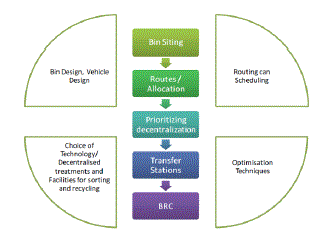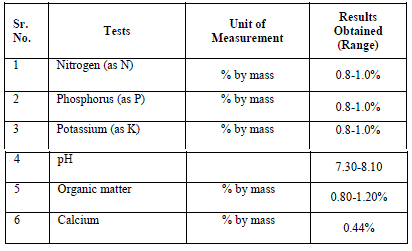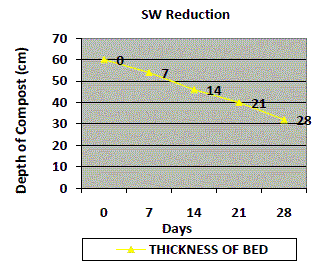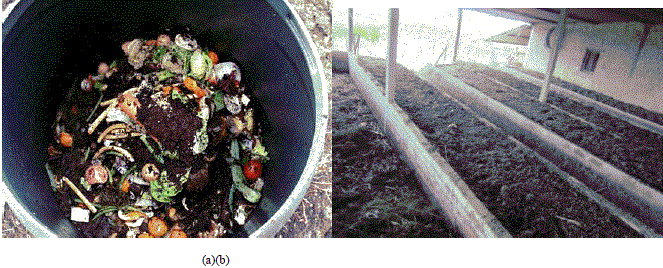ISSN ONLINE(2319-8753)PRINT(2347-6710)
ISSN ONLINE(2319-8753)PRINT(2347-6710)
VishvajitB. Kokate1, V.V. Sasane2
|
| Related article at Pubmed, Scholar Google |
Visit for more related articles at International Journal of Innovative Research in Science, Engineering and Technology
Objectives of Decentralisation are creating a clean hygienic environment free of garbage in the selected area, minimizing of waste disposal, utilizing waste as a resource for the generation of wealth, converting biodegradable waste into compost, to educate the community and make them aware of their roles and responsibilities, to involve community in solid waste management. Vermitechnology can be a promising technique that has shown its potential in certainchallenging areas like augmentation of food production, waste recycling, management ofsolid wastes etc. There is no doubt that in India, where on side pollution is increasing due to accumulation of organic wastes and on the other side there is shortage of organicmanure, which could increase the fertility and productivity of the land and producenutritive and safe food. So the scope for vermicomposting is enormous.
Keywords |
| Decentralisation, Vemiculture, Municipal Solid Waste, Compost, Revenue |
INTRODUCTION |
| Landfills are the most commonmeans of solid waste disposal. But, the increasing amount of solid waste is rapidly fillingexisting landfills, and new sites are difficult to establish. Alternatives to landfills include theuse of source reduction, recycling, composting and incineration, as well as use of landfills.Incineration is most economical if it includes energy recovery from the waste. Energy can berecovered directly from waste by incineration or the waste can be processed to producestorable refuse derived fuel (RDF). |
| Generally speaking, waste collection service does not reach the entire population of the urban centers. On the other hand people are not aware of the facilities provided, resulting in uncollected waste, which can exceed 20 - 50%. The collection ratio varies from city to city and the systems are either inadequate or inefficient. Most of the collection systems range from the use of small and impoverished metal or plastic containers or enclosures and waste platforms to well-monitored bins, which are grossly inadequate. The transport systems include a great variety of vehicles. If more efficient collection trucks are under operation the age of the fleet in general is old and their availability is low. |
A. Vermitechnology |
| ïÃâ÷ Vermicultureis the process of breeding worms. Growers usually pay for their feedstock, and the worm castings are often considered a waste product. Vermiculture is the culture of earthworms. The goal is to continually increase the number of worms in order to obtain a sustainable harvest. The worms are either used to expand a vermicomposting operation or sold to customers who use them for the same or other purposes. |
B. Objectives |
| Objectives are as follows: |
| ïÃâ÷ To create a clean hygienic environment free of garbage in the selected area. |
| ïÃâ÷ To minimise waste disposal. |
| ïÃâ÷ To utilise waste as a resource for the generation of wealth. |
| ïÃâ÷ To convert biodegradable waste into compost. |
| ïÃâ÷ To educate the community and make them aware of their roles and responsibilities. |
| ïÃâ÷ To involve community in solid waste management. |
| ïÃâ÷ To assess amount of waste generated. |
| ïÃâ÷ To assess existing status of collection, transportation and segregation of waste. |
| ïÃâ÷ To assess waste characteristics and disposal activities. |
| ïÃâ÷ To assess present awareness programs. |
| ïÃâ÷ To assess and give recommendations/suggestions for suitable guidelines to enable the municipal authorities to formulate proper action plan for better MSW management. |
| A lot of research has been carried out by the various researchers as follows: |
| HitaUnnikrishnan, BrundaGowrav and Sabrina Jathanha [1] have studied to assess the various factors that govern the sustenance of a decentralised solid waste management system in urban India. V.K. Garg[2] has studied Aristotle called worms the “intestines of the earth” and stated that there may not be any other creature that has played so important a role in the history of life on earth. |
II. METHODOLOGY |
A. Process Description |
| It was a challenge to determine the parameters, which make decentralised models successful. Any waste treatment venture adopts a specific technology for treating the wastes it receives. The selection of the technology and the skill with which it is carried out reflect the sustenance values of the venture. |
| The technology’s influence on the running of a model is assessed through its simplicity, economic viability and the skill with which it is executed. Also it is evaluated in terms of its ability to address every aspect of materials present in the Municipal Solid Waste [Figure1]. |
 |
B. Execution of Work |
| ïÃâ÷ Present Scenario: |
| Solid Waste management activities comprise of road sweeping, door step collection, drain cleaning and cleaning of toilets: |
| ïÃâ÷ Contract is not given to a Private Company. Municipal corporation is operating the system. |
| ïÃâ÷ Only 18 ghantagadis have reached 60% properties in doorstep services. |
| ïÃâ÷ Nearly 10 tractors are operating in various parts. |
| ïÃâ÷ No placing of waste collecting bins on different places. |
| ïÃâ÷ No separate system for collection of hotel waste. |
| ïÃâ÷ Road sweeping is per drill and fairly satisfactory. |
| ïÃâ÷ Collection of Waste, Segregation at Source: Though residents are encouraged to segregate the waste at Source, it is not that effective. |
| ïÃâ÷ Transportation, Waste collected is transported by contractor to designated area. |
ïÃâ÷ Scope: |
| ïÃâ÷ The project proposed is confined to municipal solid waste. |
| ïÃâ÷ Area Information: |
| ïÃâ÷ Target Phase: KOPARGAON TAHSIL (SECTOR-1) |
ïÃâ÷ Town Profile |
| Kopargaon is a town and municipal council in Ahmednagar district in the Indian state of Maharashtra. Kopargaon is located some 18 km from holy town of Shirdi. Kopargaon is situated at 19o53’N 74o29’E / 19.88oN 74.48oE. It lies on the banks of Godavari River. As of the 2011 India census, Kopargaon town has a population of 63,000. The area of Kopargaon is 725.2 km2. |
| Area: Area Map |
| No. of Households (Market place, Schools, Commercial places, Bus stand etc.): 30 |
| Population: 1350 |
ïÃâ÷ Sample Collection: |
| MSW was collected from one of the major garbage dumping site – Gandhinagar area at Kopargaon, and the vegetable MW was collected from its main vegetable market, which comprises of different left over vegetables such as cabbage, brinjal, tomato, potato, onion, carrot, turnip and leafy vegetables. Five samples of each waste were collected randomly and then were mixed to form composite samples before taking smaller sub-samples for analysis. |
| These wastes were characterized and segregated into biodegradable and non-biodegradable components andfurther into various sub-categories Each of the samples of waste of later category were segregated andcategorized manually into various waste types like paper, plastic, metals and polythene bags, etc., put into plasticsacks and weighed to determine its fraction in the total MSW sample. |
ïÃâ÷ Waste Quantity Estimation: |
| ïÃâ÷ Per Capita Waste generation is estimated at: 0.3 kg per day |
| ïÃâ÷ Estimated capacity of waste per day: |
| 1350 households x 0.3 kg = 405kg |
| Quantity excluding mix-up: at 75% = 304 kg |
| ïÃâ÷ Bifurcation of waste |
| Wet 70% = 213 kg. |
| Dry 30% = 91 kg. |
ïÃâ÷ Nutrient content Estimation of Vermicompost: |
| The final product from vermicomposting after 7, 14, 21 and 28 days of processing were sent for testing to SSKL, Sahajanandnagar, Kopargaon and nutrient composition results obtained are as follows: |
| ïÃâ÷ The nutrient composition found excellent for Agricultural use. |
| ïÃâ÷ MSW availability |
| It is understood by house hold survey, that 80 to 85 tonnes of MSW in Kopargaon is being generated every day. The available quantities can safely and conveniently generate about 3 MWs of power or can be converted in to vermin compost as manure for farmers. See TABLE I. |
 |
 |
ïÃâ÷ Method of Preparation of Vermicompost: |
| ïÃâ÷ A thatched roof shed preferably open from all sides with unpaved (katcha) floor is erected in East-West direction length wise to protect the site from direct sunlight. A shed area of 12’X12’ is sufficient to accommodate three vermin beds of 10’X3’ each having 1’ space in between for treatment of quintals of waste in a cycle of 40-45 days. The length of shed can be increased/decreased depending upon the quantity of waste to be treated and availability of space. |
| ïÃâ÷ The height of thatched roof is kept at 8 feet from the centre and 6 feet from the sides. The base of the site is raised at least 6 inches above ground to protect it from flooding during the rains. |
| ïÃâ÷ The cardboard and newspaper were wetted in a bucket of water; and allowing the excess water to run out before using. |
| ïÃâ÷ Waste collection in bins and vermibeds are shown in figure 3 and figure 4. |
| ïÃâ÷ The basal layer from the bottom was lined by a mixture of 2/3 shredded cardboard and 1/3 shredded newspaper, as bedding material. |
| ïÃâ÷ The next layer was spread evenly, then adult worms was supplied. Every 1-2 days, 1-2 kg of old manure was added. The surface was covered by shredded newspaper to keep moisture. |
| ïÃâ÷ The vermin beds are laid over the raised ground as per the procedure. The site marked for vermin beds on the raised ground is watered and a 4”6” layer of any slowly biodegradable agricultural residue such as dried leaves/straw/sugarcane trash etc. is laid over it after soaking with water. This is followed by 1” layer of Vermicompost or farm yard manure. The loaded waste is finally covered with a Jute Mat to protect earthworms from birds and insects. Water is sprinkled on the vermin beds daily according to requirement and season to keep them moist. |
| ïÃâ÷ The waste is turned upside down fortnightly without disturbing the basal layer (vermin bed).The appearance of black granular crumbly powder on top of vermin beds indicate harvest stage of the compost. Watering is stopped for at least 5 days at this stage. The earthworms go down and the compost is collected from the top without disturbing the lower layers (vermin bed). |
| ïÃâ÷ The first lot of Vermicompost is ready for harvesting after 2.2 ½ months and the subsequent lots can be harvested after every 6 weeks of loading. The vermin bed is loaded for the next treatment cycle. A tractor load of MSW is collected and it is dumped in the dump yard. The MSW is segregated i.e., all the dry wastes such as clothes, carry bags and other dry wastes are segregated from wet waste. |
| ïÃâ÷ The wet waste is pulverized and arranged in the form of bed of dimensions as per the Table II below: |
| ïÃâ÷ The bed is wetted and the compost is prepared. |
| ïÃâ÷ There will no changes in the dimensions of bed and in the weight of MSW when it changes to vermin compost. |
 |
ïÃâ÷ Procedure of Measurement of Depth of Vermicompostingperiodically: |
| ïÃâ÷ The depths of vermibeds were measured on 7, 14, 21 and 28 days to note the depth of the vermibeds. |
| ïÃâ÷ After end of 28 day, it was observed that the vermis are treating and digesting the all biodegradable waste i.e., cardboard, newspapers, garbage, market waste etc. |
| ïÃâ÷ So, it is clear that, after treating MSW by vermis, the vermicompost is forming and thereby the depth is also reducing. |
| ïÃâ÷ It is observed that vermis showing more likings towards the cooked food as compared to grass clippings etc. So, the time period required for treating the MSW is less as compared to farm products. |
| ïÃâ÷ In a vermibed of size 60’×49’×23’, 35 kg of biodegradable materials have been put for treating by vermis and 24 kg of vermicompost of good quality have obtained from it. |
| ïÃâ÷ So, out of the total weigth of material, byproduct vermicompost is obtained in the range of 2/3rd of it. |
| ïÃâ÷ The Figure 2 also shows graph of after each interval there is reduction in depth of vermibed. |
 |
 |
III DISCUSSION AND RECOMMENDATIONS |
A. Reduction of MSW at source |
| ïÃâ÷ House Hold Survey |
| ïÃâ÷ Collect the house hold garbage first of all pick 10% of houses in the division so that the sample shall be correct. |
| ïÃâ÷ In collecting sample there must include all the type of constructions like schools, colleges, factories, hostels, hospitals etc., The samples are collected separately i.e., wet (vegetable waste, kitchen waste etc.) & dry waste (papers, room waste, bags, boxes etc.). This sampling process is continued for seven days so that we can predict the average value. |
| ïÃâ÷ The results of the analyses show that MSW contains Organic matter and miscellaneous materials (bricks, fine dust, rubber, wood, leather, wastewater, etc.). The percentage of recyclable materials (glass, paper, plastic, metals) has been found to be very low. This may be due to rag pickers, who collect and segregate recyclable materials from collection points and disposal sites. |
| ïÃâ÷ The municipal solid waste (MSW) from Kopargaon town was collected, the organic materials were separatedand air dried, chopped into 3–5 cm size and subjected to predecomposition openly by sprinkling water and turningfor 15 days. Plastic containers of 45×35×15 cm size were filledwith 2 kg of pre-decomposed MSW. |
| ïÃâ÷ The cardboard and newspaper were wetted in a bucket of water; and allowing the excess water to run out before using. |
| ïÃâ÷ The first 5cm from the bottom was lined by a mixture of 2/3 shredded cardboard and 1/3 shredded newspaper, as bedding material. |
| ïÃâ÷ The next layer was 5cm of pH neutral castings spread evenly, then 1-2kg/m² of adult worms was supplied. Every 1-2 days, 1-2kg of old manure was added. The surface was covered by 5cm shredded newspaper to keep moisture. |
| ïÃâ÷ Cowdung (CD) was mixedwith pre-decomposed MSW. CD was mixed on dry weight basis (w/w). |
| ïÃâ÷ CD was made into slurry with water in 1:1 ratio (w/v) and mixedwith MSW finally before adding to vermibeds. The vermibed wasallowed 24 h for stabilization. |
| ïÃâ÷ Vermis are added. The average moisture content of the vermibedwas maintained at 75% and the substrate was turned once in aweek and the experimental setups were maintained in a controlledenvironment for 50 days. Samples were collected at the initial and,after 50 days, the vermicomposts were removed and sievedthrough a 2 mm sieve to exclude the worms. |
| ïÃâ÷ The results from the survey reveal that the per capita MSW generation rate is nearly 0.12 kg/capita/day. The per capita generation rate for various areas in Kopargaon city is calculated. This rate varies from 0.15 kg/capita/day to 0.35 kg/capita/day in Sector-1 in Kopargaon Municipal area. The households are selected randomly from the divisions so that the entire area of the division is covered. The opinion of the public regarding the services of MCK collected from the questionnaires. |
| ïÃâ÷ The experiment for this study was conducted as follows: Plastic containers of 45×35×15 cm size were filledwith 2 kg of pre-decomposed MSW. |
| ïÃâ÷ Several small holes (approximately 5 mm in diameter) were made in the sides of the container to provide aeration and to avoid water logging. |
| ïÃâ÷ A layer of sand about 5-cm thick was bedded into the container and then topped with 15 kg of compostable household organic waste which had been chopped to reduce its size and volume. |
| ïÃâ÷ It should be noted that to avoid disordering in the vermicompost production process, materials considered unacceptable to earthworms including citrus, garlic and onions, meat, dairy products, fish and beans were separated and removed. |
| ïÃâ÷ After, adult earthworms were inoculated into the experimental set (vermicomposting), and then a little water was added to the initial worm bedding to maintain its moisture content and was spread over the bedding material in the container. |
| ïÃâ÷ It was then topped by 2.5 cm of sieved garden soil. The surface of the bed was covered. The organic waste was turned periodically (once every few days) for better aeration and to mix its contents. Earthworms and the initial substrate were collected from breeding farm. |
| ïÃâ÷ The composting process was allowed to continue for periods of 7, 14, 21, 28 and 40 days. Samples were collected after 7, 14, 21,28 and 40 days and dried at 75°C for 24 h (1 kg per volume) and finely powdered. For observing and measuring parameters for changes due to earthworm activity, samples were taken from the soil at the start of the experiment. |
B. Revenue to MCK |
| ïÃâ÷ The income was calculated based on the amount generated from door to door collection and sale of byproducts and products. Expenditure was figured out through the operational costs in terms of rent of the allotted area, salaries, consumables, electricity and water bills. Also depreciation costs (at an assumed rate) for hardware installed at the facility were added to this expenditure on an annual basis to arrive at the total expenditure. Community support and socio-economic status: Since these facilities are one of a kind, intellectual (in terms of scientific advisors) and financial support were received from senior citizens, municipalities and local residents. |
| ïÃâ÷ Due to such a support, an adequate working capital was built to run the facility for some time till it started generating revenue. In community initiatives, the support of the residents is very crucial either in terms of segregation at source or paying the monthly or even tolerating the odor and spillages during mishandling. |
| ïÃâ÷ Parallel government initiatives: A parallel government initiative to treat the Municipal Solid Waste can have serious repercussions on an existing community based venture. |
C. Decentralised Bin Locations |
| A decentralised initiative has many indirect advantages. The localized collection and processing of wastes, avoids the carting of wastes too far off dumping sites. It reduces the expenditure of imported diesel, consequent traffic congestions, air pollution and road maintenance costs. It also reduces the contamination of ground water through the seepage of leachates. |
| The government should thus see the advantages of treatment of wastes locally, and provide better initiative to communities in order to make this practice more widespread. It becomes necessary to locate the bins in decentralised locations. |
IV. CONCLUSIONS |
| Above results and discussion gives us the idea that, the MSW can be very effectively controlled by adoption of Decentralised collection and treating collected MSW with Vermitechnology. Applications of both the systems simultaneously have proven to be more advantageous over the other systems in following aspects: |
| ïÃâ÷ Vermicomposting is self-promoted, self-regulated, self-improved & self-enhanced, low or no energy requiring zero-waste technology, easy to construct, operate and maintain. |
| ïÃâ÷ After treating biodegradable MSW with vermis, byproduct vermicompost is obtained in the range of 2/3rd of it. |
| ïÃâ÷ So, it is efficient than any other treatment method as it gives earlier results, it is cheaper, requires minimal manpower etc. |
| ïÃâ÷ MCK can generate revenue by saling the byproduct i.e., biofertiliser as its contents all nutrient values in it. Now, we are concentrating on reduction of MSW at source. So, expected results are as follows: |
| ïÃâ÷ It creates a clean hygienic environment free of garbage in the selected area. |
| ïÃâ÷ It minimises waste disposal. |
| ïÃâ÷ It utilises waste as a resource for the generation of wealth. |
| ïÃâ÷ It converts biodegradable waste into compost. |
| ïÃâ÷ To educate the community and make them aware of their roles and responsibilities. |
| ïÃâ÷ To involve community in solid waste management. |
| ïÃâ÷ To assess amount of waste generated. |
| ïÃâ÷ It should be effective in treatment of Household biodegradable waste. |
| ïÃâ÷ It treats the biodegradable waste at the source and reduction of MSW is done at the source. |
ACKNOWLEDGEMENTS |
| My Guide, all the faculty members and management personals of our Institute, for this study are gratefully acknowledged. |
References |
|